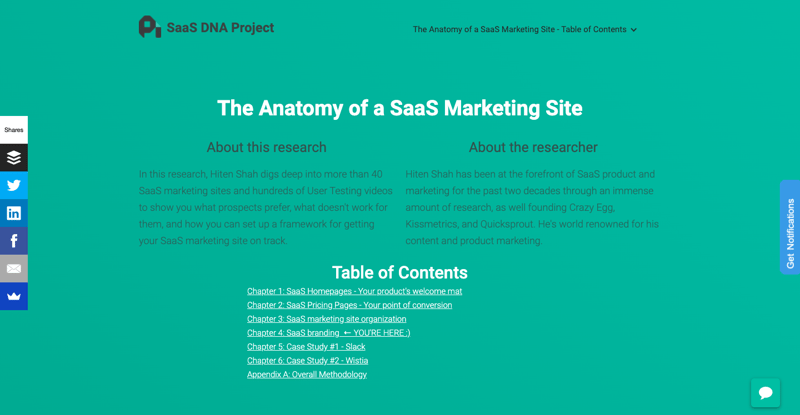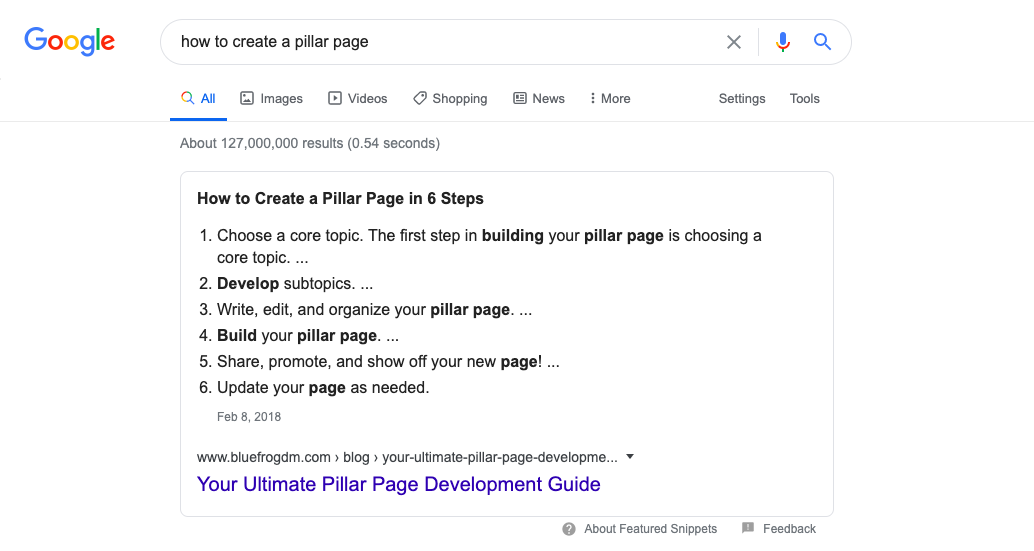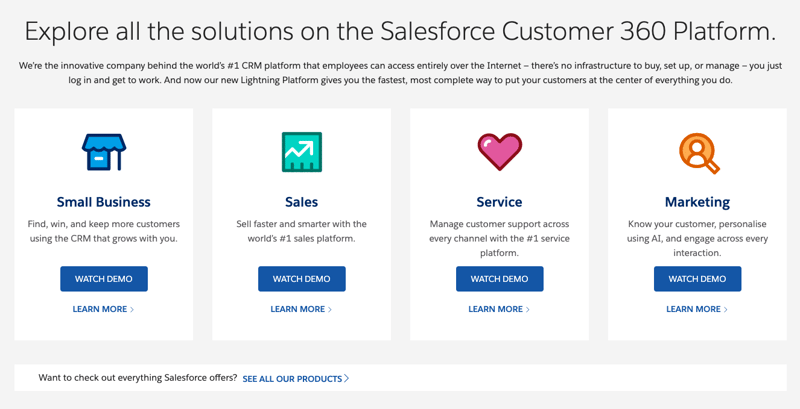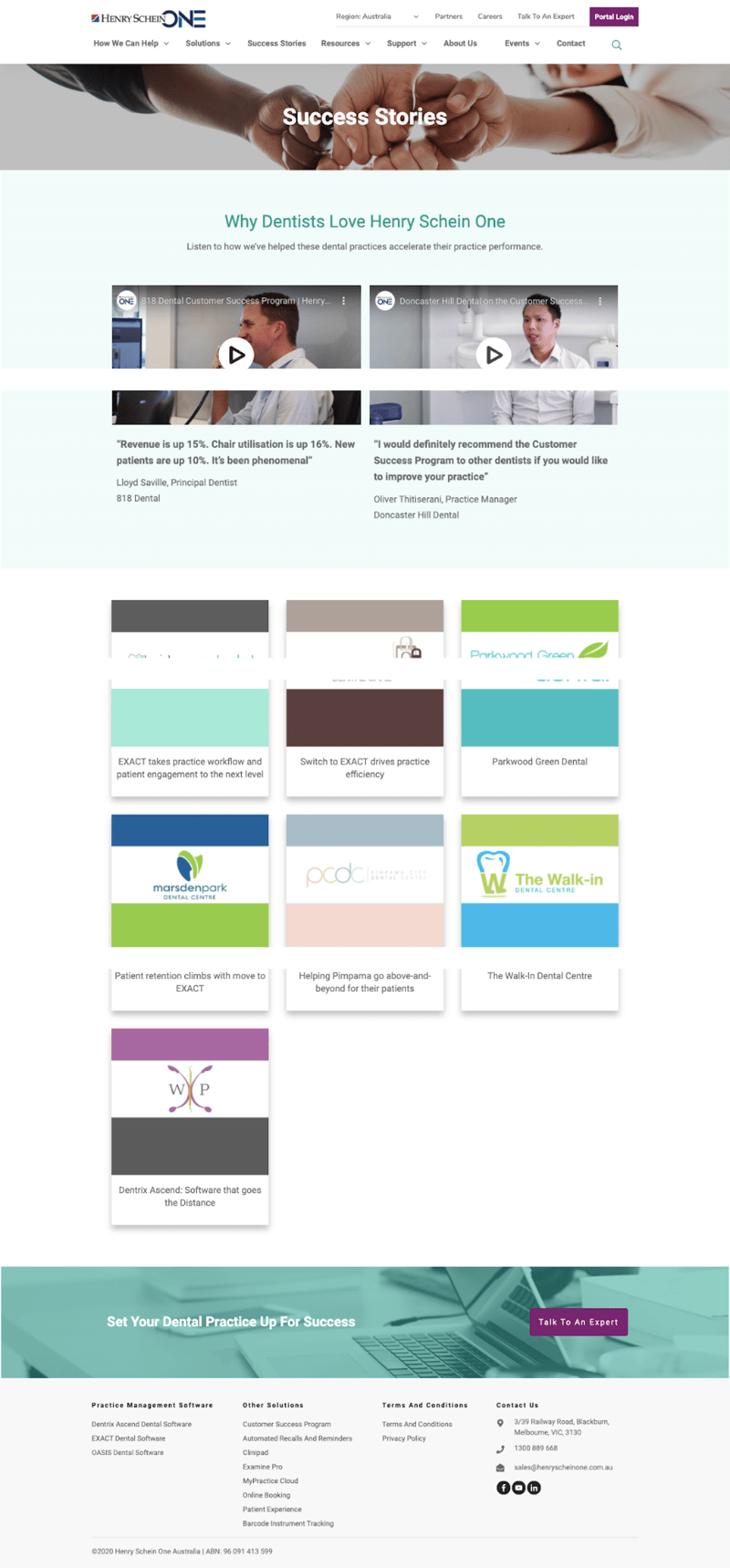Believe it or not, people are wising up.
Interruptive pop-ups with abrasive colours and messages in all-caps don’t work anymore - especially for first-time customers. Neither do those sneaky ads that worm their way into your Instagram feed or Messenger apps - we know you’re listening, Facebook...
It’s true, a study showed that 96% of consumers don’t trust advertising. After years of bombardment from commercials on TV, radio, and the internet, people are now highly suspicious of sleazy salesmen, loud signage, and those straight-up ridiculous infomercials.
Distrust is the main reason why so many paid ad campaigns fail miserably for businesses. Paid ads might initially sound enticing to a marketing manager or business owner - just throw some money at an ad campaign and get X number of clicks in return. No biggie.
But, in reality, you’re not paying for customers - you’re just paying for exposure. Don’t say it! Any exposure is NOT good exposure, this is Software as a Service, not Donald Trump’s Twitter. Exposure in the SaaS world doesn’t get you customers, just empty marketing spends and a disgruntled audience.
And that’s why inbound trumps (hehe) outbound.
Now, we aren’t hating on digital advertising - when done correctly it can be a powerful way to drive immediate, qualified prospects. But once your budget runs out, so does the advertising, and do you really want to get stuck competing for who has the biggest ad spend?
You need to think about long-term sustainability for your marketing plan. To attract your audience’s attention and earn their trust over time, consider investing in an inbound marketing campaign - powered by strong content marketing and clever SEO strategies.
And to create a highly-effective inbound marketing strategy for your SaaS business, you’ve got to put the right kind of content in front of the right kind of people - at the right time.
Cue the cringe-worthy lingo that makes every marketer shrink into their chair and groan. You guessed it - ToFu, MoFu, BoFu.
We’re taking it there. Today, we’ll show you how to nail your SaaS inbound marketing by implementing high-quality, strategic content at each marketing funnel stage. As you steadily build up your content and organic positioning across the funnel, you’ll be growing a steady stream of quality traffic and leads you won’t have to keep paying for!
Let’s get into it.
What is SaaS Inbound Marketing?
In a nutshell, SaaS inbound marketing is a strategic approach to attracting, engaging, and delighting customers by providing valuable content and experiences throughout their buyer's journey.
Picture this: you've got a fantastic Software as a Service (SaaS) product, but your potential customers are playing hide and seek with your website. What's a savvy marketer to do? That's where SaaS inbound marketing swoops in to save the day!
Now, there as several stages to this kind of marketing, each of which serves a distinct purpose. Let's unpack together.
- Awareness Stage: It all begins with the awareness stage. Your prospective customers might not know they have a problem yet, but fret not! Inbound marketing shines its spotlight by creating captivating content that grabs their attention, educates them about their challenges, and introduces your SaaS solution as the superhero they need.
- Consideration Stage: Ah, the consideration stage—where your prospects weigh their options and research different solutions. This is your moment to shine! Inbound marketing continues to charm by providing valuable resources, like blog posts, eBooks, or videos, that demonstrate your expertise and showcase the unique benefits of your SaaS product.
- Decision Stage: The decision stage is where the magic happens. By now, your prospects are well-acquainted with your brand and solutions. It's time to seal the deal!
Inbound marketing swoops in with compelling case studies, product demos, and personalized consultations, giving your potential customers the confidence they need to choose your SaaS offering and become loyal advocates.
What is SaaS Inbound Marketing vs Outbound Marketing?
Here's the deal: SaaS inbound and outbound marketing are like the yin and yang of the marketing world. Let's dive into a thought-provoking comparative table to see how they stack up against each other.
|
Criteria |
SaaS Inbound Marketing |
Outbound Marketing |
|
Approach |
Charming and charismatic, like a captivating storyteller. |
Interruption-based, like a persistent door-to-door salesperson. |
|
Audience |
Attracts and engages potential customers organically. |
Casts a wide net, targeting a broad audience. |
|
Content |
Valuable, informative, and tailored to customer needs. |
Promotional, sales-oriented, and often generic. |
|
Timing |
Connects with customers throughout their buyer's journey. |
Disrupts customers' daily lives, often at inconvenient times. |
|
Cost |
Requires long-term investment but yields sustainable results. |
Often expensive upfront costs with uncertain ROI. |
|
Relationship |
Builds trust and fosters long-term customer loyalty. |
Transactional and focuses on immediate conversions. |
SaaS inbound marketing brings a touch of charm and finesse to the marketing game, engaging customers throughout their buyer's journey and building lasting relationships.
Remember, in SaaS inbound marketing, captivating content and a genuine connection with your customers are the secret ingredients to success.
7 Effective Inbound Marketing Strategies for SaaS Companies
We can't talk about SaaS inbound marketing without mentioning some effective strategies. Here are seven strategies you need to start implementing now.
1. Earn Their Attention With SEO (TOFU)
Top of the Funnel is the very start of the SaaS inbound marketing funnel. This is where a wide audience of complete strangers come to your website, and it’s your job to make a good first impression and keep them on your site.
With the help of a killer SEO strategy, you can gradually attract your customers' attention as a reputable source of information - not some dubious suspect firing paid ads at total strangers.
Leveraging SEO marketing is essential for SaaS companies to succeed in the early ‘Attract’ stages of the marketing funnel. If one of your articles comes up on a Google search, the immediate response is ‘great, this looks helpful’.
First impressions count, and if you’re targeting the right search queries with purpose-built, valuable content, your business will immediately hit it off with potential customers. Customers believe that if a search engine has decided your content is good, it must be good.
Basically, the more you invest in SEO marketing over a long period of time, the more positive impressions will be made with your audience right off the bat. That means a greater chance of a stranger becoming a prospect in the marketing funnel's critical ‘attraction’ stage.
Creating and implementing a solid SEO strategy for SaaS inbound marketing requires the following specialist tasks:
- Research the right search phrases to rank for
- Analyze your competitors’ keywords
- Produce quality content using targeted search phrases
- Build links with your content to create effective topic clusters
- Repurpose any old content to better fit your strategy
- Maintain a consistent level of output each day, week, month, etc.
It’s a never-ending mission, but the long-term results of your SaaS inbound marketing strategy are bound to be worth your while regardless of whether you reach the top of page one. That’s because the process of implementing SEO-driven tactics forces you to create and share strategic, consistent and valuable content - using the keywords and phrases your audience is looking for.
There are many SEO strategies that your company could use, but we’ve put together the tactics that are perfect for your SaaS inbound marketing strategy at the ‘Attraction’ stage of the marketing funnel.
Here are 3 SEO strategies you can use for SaaS inbound marketing:
Build a Pillar Page
A pillar page is a collection of content relating to one large topic. You have one central ‘pillar page’ which branches off into smaller, more specific articles covering all the topics within that central pillar.
By covering every possible topic under one large subject, organizing the content for easy navigation, and linking between the articles, pillar pages create a goldmine of content to educate audiences. It’s a brilliant way for SaaS companies to demonstrate expertise and provide new visitors with valuable information - the gold standard for instilling trust with an audience.
Plus, creating well-structured content that targets search phrases under each topic and builds links within your content is going to give your SEO efforts a massive boost. As Google’s algorithms get even better at discerning the context and intent behind searches, content that captures multiple variations of search phrases is going to rank well.
Search engines love internal links and long-form content, so the structure of a pillar page doesn’t just provide helpful navigation for visitors - it tells Google that your website is a relevant and trustworthy source.
Example: ProfitWell’s The Anatomy of a SaaS Marketing Site

ProfitWell is a revenue growth platform, with solutions to support SaaS companies in maximizing their revenue potential and minimizing churn. Saying that your company “solves the hardest parts of subscription growth” is a pretty big call. To back themselves, ProfitWell provides visitors with an impressive amount of well-structured, high-value content.
What stands out is their SaaS pillar page, which takes visitors on a deep dive into the marketing strategies to use in SaaS websites. The authoritative voice of the content is that of Hiten Shah, a SaaS expert who founded Crazy Egg, Kissmetrics, and Quicksprout with Neil Patel.
With internal links, infographics, real-world examples, and a handy ‘you are here’ indicator telling visitors where they’re up to in the pillar, this masterpiece of valuable content demonstrates the power of a pillar strategy.
Aim for Featured Snippets on Google
Featured Snippets are found at the top of SERPs and aim to provide an immediate answer to someone’s search query.

The top spot gets 31.7% of all clicks, so targeting featured snippets is a solid SaaS inbound marketing strategy. If you manage to secure the top spot, first-time visitors are immediately attracted to your content that answers their questions before they even decide where to click.
There are 3 kinds of featured snippets, listed in order of popularity:
- Paragraph
- List
- Table
To start targeting featured snippets in your SEO content strategy, make sure you’re answering likely search questions in your content, then include either a succinct description, a detailed list, or a helpful table at the top of each blog post.
Doing this successfully takes thorough research into your specific SaaS vertical, and the featured snippets your competitors are ranking for, so make sure you take the time to form a detailed strategy before implementing this tactic.
Target Long-Tail Keywords
To benefit from SaaS inbound marketing with SEO strategies, you need to be targeting long-tail keywords. Long-tail keywords are typically longer than four words, and contain direct questions such as ‘how to do x’ or ‘what x should I use’.
The specificity of long-tail keywords means they generally attract a lower volume of traffic, but what they do attract has a high chance of converting. Long-tail keywords make up 70% of search queries and convert 2.5x more than short keywords.
Targeting long-tail keywords achieves a couple of other useful content tactics as well, so you actually end up killing three little birds with one stone.
As well as nailing the long-tail keyword strategy, you naturally end up aiming for short keywords as well. ‘Effective inbound marketing for SaaS’ also targets ‘inbound marketing for SaaS’, ‘inbound marketing’, and ‘marketing for SaaS’.
Plus, making a conscious effort to weave keywords into your content helps eager and busy readers who are scanning for useful content relevant to their search query. By including long-tail search queries often (without sounding like a robot), you’ll be helping potential customers find the information they’re looking for.
SEO is tricky to get your head around, so we’ve summarised the above in a helpful table.
|
SEO Strategy |
Definition |
Benefits |
|
Pillar Page |
One large page covers the overall subject, which breaks down into smaller articles that cover smaller subtopics that all link together to form topic clusters. |
|
|
Featured Snippets |
Organic content featured at the top of a SERP that succinctly answers the search query and links through to the website.. |
|
|
Long-Tail Keywords |
Keyword strategy targeting phrases with four-or-more words, usually ‘how to x’ or ‘what is x’ or ‘x for y’. |
|
2. Educate Your Audience With Blogs (TOFU)
Once you’ve nailed your SEO strategies, it’s time to implement them with top-quality blog content.
The nature of the SaaS industry calls for educational content to be at the center of any inbound marketing strategy for lead generation. Tech is complex and ever-evolving, so people at the top of the marketing funnel have to learn about your product and the challenge it fixes in order to appreciate its value right off the bat.
Consumers also need to know that they’re getting information from a trusted authority, a business that can stand up and say ‘we wrote the book on this sh*t’ before presenting a goldmine of content to prove it.
That’s why blogs are so crucial. I’ve ranted before about why blogs are such an important
part of content marketing for a SaaS inbound marketing strategy, but I’m going to do it again.
Why? Because every SaaS business is doing it, and there’s so much evidence to show that it works - especially at this stage of the marketing funnel where customers have never come across your business before.
There are hundreds of stats out there proving the value of blogs, but here are 3:
- 77% of internet users read blogs
- Blogs are in the top 5 most trustworthy online sources
- 92% of companies who blog multiple times per day have acquired a customer from their blog
A stranger to your company knows absolutely nothing about what you do or how you can help them. They don’t know if your software is going to be valuable to them, and they aren’t sure if you understand who they are and what they need.
Because of this, information is the greatest asset for your SaaS inbound marketing strategy. Remember, this industry is about service, so focusing on the value you’re offering to customers is going to instill confidence and trust in your business. Teach your customers about what your software does, placing the most emphasis on how it helps make their lives better. Explain it with detailed guides for each customer persona, and back it up with in-depth industry research.
Another important factor to consider is that they don’t know what your business stands for, and these days the majority of consumers prefer purpose-driven companies. As you educate your audience, the language, personality, and messages you share are a constant demonstration of your brand’s values - that’s the real sh*t customers are looking for in a business.
Enough lecturing, time for real-world examples. Let’s look at an industry leader using educational blogs for their SaaS inbound marketing.
You might have heard of Wix. Wix is an AI website building platform pitched to first-time users, sole traders, and small business owners. Their messages are all about freedom, creativity, and support, offering web design noobs a means of building a website without breaking the bank and without being embarrassed by the result.
Their blog is a treasure trove of educational content stretching across business management advice, web design top tips, inspiration, branding how-to’s, marketing guides, and even a 101 lesson on TikTok.
By leveraging educational content marketing, Wix presents itself as more than just a web design tool - they’re a go-to guide for any and every business owner. Plus, the hundreds of useful and diverse article topics mean hundreds of entry points attracting new visitors to the Wix website, to then become interested leads and paying customers.

3. Offer Whitepapers, eBooks, & Courses In Exchange For Contact Details (MOFU)
Alright Mofos, now we’re at the MoFu stage. The middle of the SaaS inbound marketing funnel is where visitors have become familiar with your content, they might like the way your business talks, but they’re one of the 50% of leads that aren’t ready to get out their credit cards or give away their email addresses.
First, they need to get a bit deeper into the value of what’s on offer and figure out whether you’re really as good as you say you are. At this point, they know what you do and they’ve done a fair bit of research, so you’d best believe they’re comparing you to your competitors!
This is a critical part of the marketing funnel where 68% of companies get their strategies wrong and lose potential customers.
Basically, you can’t be messing around with your inbound SaaS marketing strategy at this point. To convince your leads to make that extra step, your content has to be in-depth, research-driven, and precise. The purpose is to nurture the relationship with prospects and establish enough trust for them to give you their contact details in exchange for some gold-standard content.
Here are a 4 ways to nail your MoFu SaaS inbound marketing:
|
Strategy |
Definition |
Features |
Example |
|
Whitepaper |
A research paper providing in-depth analysis about your software and what it achieves for customers. |
|
|
|
eBook |
A longer research paper providing in-depth thought leadership and guidance on a specific topic that solves customer pain points. |
|
|
|
Course |
A series of helpful content delivered through lecture-style videos to provide specialised education and ‘insider’ knowledge from an industry leader. |
|
|
|
Webinar |
A live educational video delivered by an influential figure within the business. |
|
All of the above are effective inbound marketing strategies for SaaS companies at the MoFu stage of the marketing funnel. In exchange for their contact details, leads are sent more targeted content via email that aims to convert interested leads into paying customers.
Targeted email newsletters are the bread and butter of MoFu marketing, and 59% of B2B marketers say it’s their most effective channel for revenue generation. This is because it’s an opportunity to segment leads based on certain characteristics, such as customer personas or pain points, to then send relevant and personalized content to maximize potential conversions.
This method is being used successfully by SaaS companies around the world, but Denamico wrote an illuminating case study about how they implemented a targeted email strategy and saw epic results.
Denamico overhauled its previously automated and colourless email campaign and injected it with some personalization. They included:
- Personalised greetings
- Snippets of relevant blog posts
- Invitation to upcoming events and workshops
- CTA’s to relevant podcasts and ebooks
This was the result:

The results spoke for themselves - a 43% increase in open rates and an 89% increase in click-throughs. By implementing a strategy that segmented leads in order to send specific, targeted, and relevant content, businesses can demonstrate attentiveness to their audience whilst maximizing conversions.
Remember, to make sure your middle-of-the-funnel SaaS inbound marketing strategies are increasingly effective, you’ve got to keep track of the marketing metrics behind each campaign.
4. Create Content for All Stages of the Buyer’s Journey
One of your SaaS inbound marketing secret weapons is customer-segmented content. This is a go-to method that aligns with the nature of SaaS sales, where customers decide fairly quickly to sign up for a long-term relationship. Seeing exactly how your solution works for their specific challenges is going to seal the deal very quickly.
So how do you show every individual visiting your site how your software is going to help them specifically?
Well, you design your website around the needs, challenges, and interests of each of your customer personas. If your UX is on point and you understand inbound marketing for SaaS, every potential customer will be able to click through to the holy grail of content that gives them the answers they’ve been looking for - so the only option is to click ‘buy now’.
Pro Tip: Every company worth its salt has customer personas. For SaaS companies, though, customer personas are absolutely critical for success. Your software was created with certain people in mind, right?
Whether you’re a clinical software company targeting small-town podiatrists, or a global software giant supporting other leading businesses, you’ll have an in-depth breakdown of who your customers are, down to their job description, annual salary, political views - hell, maybe even their Myers Briggs personality...
This information helps your sales team overcome objections during tricky pitches, but they should also be integrated into your website’s copy, SaaS customer landing pages, and the website UX.
Creating a customer-centric website helps to immediately convert leads by:
- Immediately showing visitors that you understand their needs
- Pointing them in the direction of relevant content
- Demonstrating that your software solves their specific challenge
- Streamlining their journey to see helpful features and prices
The result is a responsive and customer-centric website that simplifies the buyer journey by putting the right content in front of the right people.
A classic example of customer-focused web content features on Salesforce’s website. Salesforce is a powerful CRM with a wide range of customer personas - from small businesses to large e-commerce and service organizations.
Because of this wide audience base, Salesforce needs to quickly point visitors in the right direction - otherwise, they’ll get overwhelmed, confused, and click away to a simpler competitor.
Here’s how Salesforce segments visitors on the home page, pointing each customer persona to the information they need:

Each succinct CTA takes visitors through to a customer-centric landing page, which features specialized web copy that demonstrates Salesforce’s potential to deliver to that particular audience.
The landing pages include the following relevant, customer-centric content:
- Empathetic web copy showing understanding of challenges, requirements, and goals
- CTA to a free trial
- CTA to a webinar
- Testimonial
- Case study
- Plan cost break-down
- Statistical results from other businesses using the solutions
- Contact form
Check out the landing page for small businesses to see for yourself. In terms of inbound marketing strategies for SaaS companies - this is the gold standard.
5. Promote your Content with Social Media and Email Marketing
In the vast realm of SaaS, where solutions are as abundant as confused cats in a room full of yarn, getting your content in front of the right audience is essential. Enter social media and email marketing, the dynamic duo of inbound promotion.
Social Media
Social media platforms like Twitter, Facebook, LinkedIn, and even TikTok (because why not have some fun?) are bustling hives of activity where you can showcase your SaaS brilliance. Craft compelling posts sprinkled with just the right amount of wit and charm, to capture the attention of your target audience. Share valuable insights, industry trends, and expert advice that leaves your readers nodding with approval.
Email Marketing
Email marketing may seem as old as a floppy disk, but it's still a powerful weapon in your inbound arsenal. Create interesting newsletters and provide value to your subscribers. Include exclusive content, previews of upcoming features, and irresistible discounts to make them feel they have found something valuable. Ensure your emails are witty and informative, and avoid the dreaded spam folder like the plague.
6. Use Competitor Research to Help Inform Future Content
Ah, competitors, those cunning tricksters in the SaaS world. Instead of getting frustrated or resorting to petty acts of office sabotage, why not use their existence to your advantage? Competitor research can be your secret weapon for creating killer content.
Spy on the Competition: Stealth Mode Engaged
Identify your main competitors and embark on a covert mission to gather intelligence. Explore their websites, blogs, and social media profiles to uncover their strategies, the topics they cover, and the engagement they generate. Take notes like an undercover agent, but without the trench coat and sunglasses (unless that's your thing).
Unleash Your Content Creativity: The Inbound Strategist Awakens
Armed with valuable insights from your competitor research, it's time to put your creative genius to work. Identify gaps in their content offerings, find new angles to tackle common industry pain points, and develop captivating ideas that set you apart.
Don't Just Copy-Paste: Add Your Unique Flair
Remember, while competitor research is a powerful tool, injecting your unique personality and style into your content is crucial. Add a pinch of humour, a dash of wit, and a sprinkle of charm to create a distinctive voice that resonates with your audience. Be the unicorn in a sea of horses, standing out and making waves in the SaaS universe.
7. Celebrate Your Success (BOFU)
You’ve reached the final straight, the bottom of the funnel for SaaS inbound marketing. Your customer is so close to being convinced, they just need that final face-melting guitar solo of content to close the deal.
This is where case studies showcase the true value of your business - by celebrating what you’ve already achieved with your many happy customers.
Case studies are one of the most effective inbound marketing strategies for SaaS companies because they fall into the ‘delight’ category of marketing. This is where your product is proven to be so darn good that your customers end up doing your marketing for you.
This is a dramatic way to say that they prove your value by sharing their story of how your solution worked for them.
If you cast your mind all the way back to the beginning of this article, you’ll remember I cited a study where 96% of people don’t trust advertisements. What’s also interesting about that study is the group that was ranked as the most trustworthy source of information. You’ll never guess who they picked - themselves!
And that’s why testimonials are so powerful. As soon as you get a real life person talking about their experience with a product, people stop and listen. That’s what makes case studies so powerful for B2B SaaS inbound marketing.
Case studies usually involve the following things:
- An explanation of the case study participant to help potential customers relate to them
- An overview of the challenges the participant faced to help potential customers identify similar challenges
- A story about how the challenges were solved by the product to showcase its value
- An interview with the participant to instil trust and empathy with potential customers
- Statistical evidence demonstrating the success experienced with the company
- Video content or photography to give the story authenticity and entertainment value
For SaaS companies operating in niche markets with highly specific customer personas, case studies are the perfect way to highlight the value of your product and show potential customers what it’s like to work with you.
Henry Schein One Australia helps dentists with practice management software and support. Their software solutions are specifically designed to suit different kinds of practices with different challenges, requirements, and goals.
Their library of success stories features videos and blog content that highlights the results experienced by many happy customers, whilst also explaining in detail how the software works - with a real-life example to provide context.

Inbound Marketing Tips for SaaS Businesses
Once you have the right strategies, it's time to maximize your SaaS inbound marketing efforts. So, here are some tips you need to keep in mind.
Not Every Visitor Has to Convert Immediately
You know what they say, Rome wasn't built in a day, and neither are successful conversions. So don't stress if every visitor to your SaaS website doesn't whip out their credit card and subscribe right away. Instead, focus on building relationships and nurturing leads over time.
Engage, Engage, Engage!
Captivate your visitors with compelling content, whether a humorous blog post, an informative video, or an engaging webinar. Keep them hooked and wanting more. Remember, you're not just selling a product; you're providing a solution to their problems.
Convert at Their Own Pace
Offer multiple conversion points that cater to different stages of the buyer's journey. Whether signing up for a free trial, downloading an ebook, or subscribing to your newsletter, give them options to engage with your brand on their terms.
Ask Your Users What They Want to See
If you want to win the hearts (and wallets) of your SaaS users, you need to understand their wants and needs. Don't play a guessing game—just ask them!
Get Personal with Surveys
Reach out to your existing customers and potential leads with surveys to gather valuable insights. Ask them about their pain points, what they value most in a SaaS solution, and how you can improve their experience. Not only will you gain valuable feedback, but you'll also show your users that you genuinely care about their opinions.
Tailor Your Content
Once you clearly understand what your users want, tailor your content to address their specific needs. Craft blog posts, videos, and social media content that provide the answers, solutions, and inspiration they're looking for. Be the genie that grants their SaaS-related wishes!
Use Search Intent and Keyword Research in Content Creation
Keywords are like breadcrumbs that lead potential customers to your SaaS doorstep. But it's not just about stuffing your content with any old keywords—it's about understanding search intent and crafting valuable content around it.
Play Sherlock Holmes with Search Intent
Put on your detective hat and dive into the minds of your target audience. What are they searching for? What problems are they trying to solve? What kind of information are they seeking?
Armed with valuable insights, you can create content that resonates with your users—and leads them closer to becoming loyal customers.
Find the Golden Keywords
Research keywords relevant to your SaaS niche and have a decent search volume. Tools like Google Keyword Planner, SEMrush, and Ahrefs can help you uncover those hidden gems. Sprinkle these keywords naturally throughout your content to improve your chances of ranking higher in search engine results.
Continue to Optimize Your Content
In the fast-paced world of SaaS, you can't afford to rest on your laurels. Keep optimizing your content to stay ahead of the competition and attract those precious leads.
Embrace the Power of A/B Testing
Test, test, and test some more! Experiment with different headlines, call-to-action buttons, landing page layouts, and content formats. A/B testing allows you to gather data and insights on what works best for your audience, so you can make data-driven decisions and continually improve your inbound marketing efforts.
Stay Fresh and Relevant
The SaaS world is constantly evolving, and your content should too. Regularly update your blog posts, ebooks, and guides to reflect the latest trends and developments. By staying fresh and relevant, you'll position yourself as a thought leader in your industry and keep your audience coming back for more.
Conclusion
By organizing your inbound marketing strategies to the right people, and the right content, at the right time, you’ll see a serious ROI on your content marketing and SEO marketing efforts.
The ToFu, MoFu, BoFu thing is one stinker of a marketing cliche, but when it comes to SaaS companies, you’ve got to implement your content appropriately along the customer journey. That’s what the big dogs are doing - and they’re reaping the benefits.
At the end of the day, it comes down to having a valuable product and quality content to show it off. If there’s one thing that inbound marketing does for a business, it’s exposing the truth of whether your product and your messages work. If you’re not getting the response you want, it might be time to go back to the drawing board.
And if you need some help with that, give us a shout.

Chris Onyett
Chris is one of the managing partners at Roketto. His area of expertise is digital marketing and loves sharing and educating on topics like Google Ads, CPC bidding tactics, Google Analytics, and marketing automation. When Chris isn't in the office, he enjoys playing volleyball, mountain biking, and hiking with his American Eskimo.















2.png)
2.png)




